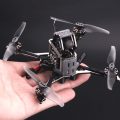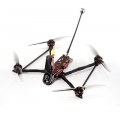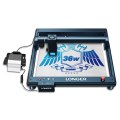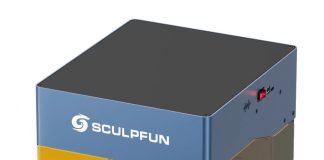Power Vision PowerEgg X
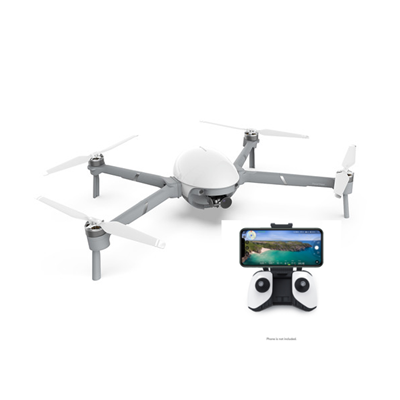
-
1: AI Camera Mode
-
2: Can capture 4K60 aerial footage
-
3: 3-axis gimbal features mechanical stabilization
-
4: Long Camera Battery Life
-
5: Gesture Commands
Power Vision PowerEgg X Personal AI Camera With 3-axis Gimbal RC Quadcopter
The Chinese drone manufacturer PowerVision has introduced the new PowerEgg X drone. The PowerVision PowerEgg X gets the egg-typical design and combines AI camera, handheld camera and flight drone in one device. We tested the PowerEgg X. In the review of the PowerEgg X drone, we clarify the most important functions as well as advantages and disadvantages.
The more expensive Wizard Bundle of the PowerEgg X drone includes two boxes. The “Waterproof Accessories Pack” includes the attachments for the drone’s water resistance. This includes swimming runners / pontoons, waterproof and nano-coated protective dome with protective housing, replacement propeller (including fastening screws and screwdriver), additional battery, transport bag and USB cable. There is currently no option to purchase the Waterproof Accessories Pack for the PowerEgg X separately and to upgrade the drone accordingly. Possibly the accessory set can also be ordered separately in the future, so that an expansion of the basic set (PowerEgg X Explorer) is also possible afterwards.
The scope of delivery of the main unit includes PowerEgg X, controller or radio remote control, various user guides and quick start guides, rotor arms, two spare propellers, microfibre bag, wrist strap, battery, power pack and charger. The accessories and the PowerEgg X will be delivered in a foam case with Velcro opening , which can also be used in the future as a transport case or storage option. This is practical and should be noted in any case.
The battery can be charged using the charger supplied. The charger not only offers a charging option for the smart battery, but also for the controller of the PowerEgg X drone. Accordingly, the charger offers two integrated USB charging ports to supply additional smart devices (e.g. the smartphone) with fresh juice. Three different USB cables are included for the connection between controller and smartphone. Depending on the brand and model of the smartphone, you can therefore use a USB cable with Lightning, microUSB or USB-C connection.
The PowerEgg X from PowerVision gives a high-quality and well-thought-out impression both visually and haptically. And the drone comes in an egg design – crazy! The high-quality impression of the gadget is also underpinned by a rather high weight, after all, the egg weighs around 522 grams without the mounted extension arm. The dimensions of the egg are 165 x 100 x 100 millimeters . In drone mode, therefore with the booms mounted, the take-off weight of the PowerEgg X is 862 grams . Compared to mini drones like the DJI Mavic Mini a drone mark is therefore necessary when using the PowerEgg X.
When the PowerEgg X is used in drone or aircraft mode, the front-mounted obstacle sensors and the downward facing ultrasonic sensors ensure stable flight conditions and safe take-off and landing procedures. GPS and Glonass are of course also on board, making the drone ideal for beginners, who can control the drone much more easily thanks to GPS positioning.
The drone egg can be unlocked and opened by pulling the lateral cloth flap. Under the plastic protective housing the PowerEgg X turns out to be a classic flying drone with camera, 3-axis gimbal and various obstacle sensors. The 3-axis compensation and camera of the PowerEgg X are secured and protected during transport by means of a clipped gimbal lock. If you press the two side release buttons while the bottom is open, the battery cover of the PowerEgg X automatically pops open. Therefore, the supplied battery is located under the upper plastic cover of the PowerEgg X. This is a 237 gram heavy 3S battery (11.4V) with a capacity of 3.800 mAh and a power of 43.32 watt hours. By briefly pressing the button, one can check the battery status with the help of four LED light displays. If you first press the battery button briefly and then hold it down for about two seconds, you can switch the battery on or off. This is nothing new and is already known from the market leader DJI.
If the PowerEgg X-drone is to be used in aircraft or drone mode, the lower protective housing and the gimbal fuse must first be removed. Afterwards, only the upper cover needs to be opened. Here you now have the possibility to plug in the two rotor arms supplied laterally. Alternatively, tripod adapters for AI mode or hand strap for handheld mode can be inserted into the side guides of the PowerVision PowerEgg X.
Once the rotor arms are in place, all that remains is to insert or attach the battery and the upper plastic cover. Before the first take-off, of course you have to make sure that the rotor arms and the foldable landing legs are completely folded out. Unlike most DJI drones, the propellers do not have a quick release mechanism and can therefore not be exchanged without tools on the PowerEgg X. To exchange the propellers, a T6 screwdriver (Torx) and corresponding screws in the M2.5×3.5 version are required. When mounting the exchange propellers, pay attention to the shape of the propeller foot. Mounting the wrong propellers is therefore impossible.
The camera of the PowerVision PowerEgg X-drone allows 4K recordings at up to 60 frames per second and is therefore largely state-of-the-art.
As an alternative to the 4K recordings, FullHD videos in 1080p resolution at a frame rate of 120 fps or 720p videos at 240 frames per second are also possible. The PowerEgg X uses a 1/2.8-inch CMOS image sensor with a resolution of 12 megapixels. The field of view (Angle of View) is 78.4° so that natural images can be recorded without strong distortion. Various photo shooting modes such as classic single shot, continuous shooting (3/5/7), bracketing (3/5 at 0.7EV) and interval shooting (3/5/7/10/15/30/60 seconds) are also on board.
The video bit rate is specified as 75 Mbps. Photos can be recorded either in the conventional .jpeg format or alternatively in Adobe’s own .dng raw data format (RAW). The memory integrated in the drone egg is six gigabytes. The memory can be expanded up to 128 gigabytes by inserting a microSD memory card. The inclination range of the gimbal is -90° ~ +20° in drone operating mode. In AI camera mode the gimbal also offers a horizontal tilt range of -55° ~﹢55°.
The live image from the drone camera is, of course, transmitted in real time – in FullHD or 1080p resolution at distances of up to six kilometres. In CE mode, which is used particularly in Europe, the transmission range is only three kilometers. However, the range of the PowerEgg X is completely sufficient and requires no improvement whatsoever with regard to visual flight control in drone flight. A similar statement can be made about the flight time of the PowerVision PowerEgg X drone, which at around 25 to 30 minutes is on a par with most consumer drones in this price class.
The highlight of the PowerVision PowerEgg X-drone is that it is the first usable and affordable consumer drone with water resistance. Market leader DJI has so far dispensed with the water resistance of DJI Mavic models or DJI Phantom models. Otherwise, things look very lean in the waterproof hobby drone segment. This is surprising, closes a waterproof drone could be used in the rain, which would significantly improve the suitability for everyday use and independence of use. PowerVision has taken up the topic of waterproofing drones and offers with the PowerVision PowerEgg X for the first time a waterproof drone. For this purpose, the manufacturer supplies the separate “Waterproof Accessories Pack”, which contains, among other things, special floating skids and a transparent plastic cover for the camera area.
This allows the drone to fly in the rain or land and take off on the water. The cover has a special nano-coating so that water drops roll off the glass bell and do not obstruct the view of the camera. However, the motors or rotors are not further protected and cannot be distinguished optically from other drone models. Nevertheless, the drone functions reliably even in adverse weather conditions. It should also be noted that the obstacle sensors are deliberately concealed when the cover is fitted and are disabled accordingly in watertight mode. If the obstacle sensors were to register reflections or water droplets, for example, flight characteristics could be affected. Therefore, play it safe by simply switching off the obstacle sensors. In addition to the deactivated obstacle sensors, the behaviour during take-off and landing in waterproof mode is also optimised.
At the same time, the PowerEgg X can be used not only in rain or snowfall, but also for take-off and landing on water. This can be especially useful if you want to take the PowerEgg X drone on a boat trip and there is no suitable landing or take-off opportunity on the boat itself. Even for aerial shots near water, it can’t be a disadvantage if the drone has a certain water resistance. The risk of a drone crash with water damage is significantly minimized, which in turn leads to more freedom in the design of aerial photographs. Since objects can also be filmed in rain, snow or high humidity, the drone can be handled more independently of weather conditions.
The PowerVision PowerEgg X convinces with its innovative design and the possibility to be used as a flying drone, as a stationary camera or as a handheld gimbal camera. Thus, the smart egg combines the advantages of three different devices, namely a flying drone, camcorder or mini-gimbal.
Therefore, if you want to combine aerial photography with vlogs, you can do without an additional selfie or vlogging camera. This not only saves money, but also space for equipment. However, you also have to live with some disadvantages, such as the bulky and impractical form factor or a rather high dead weight. Therefore, the PowerEgg X doesn’t replace an action camera. The PowerVision PowerEgg X drone is of very high quality, well thought out and versatile and has some surprises in store, which are not yet known from other drone manufacturers. These include, above all, the ability to fly a drone in the rain or to take off and land on water. This increases user-friendliness and suitability for everyday use. In view of this, the egg drone with an entry-level price of 1049 euros (from 849 euros in the Explorer Edition) offers a reasonable price-performance ratio if you are looking for a waterproof flying drone. If you want to do without this practical feature or the cool look, you can of course still go for the DJI companion drones. These are in a similar price segment, but are also noticeably better in terms of portability, user-friendliness, app functions or image quality.
SPECS
Product Details
| Features |
3-in-1 camera drone 4K camera with 60 fps 3-axis gimbal 862 grams (drone mode) 522 grams (camera mode) Max. Speed: 18 m / s Max. Range: 3 km (CE) Max. Flight time: approx. 30 minutes GPS + Glonass 12 MP camera (1 / 2.8-CMOS) 3800 mAh battery |
| Specification |
Weight: 522g Dimension: 165×100×100 mm Working Time: 4 Hours Working Temperature: 0℃~40℃ Takeoff Weight: 862g Propeller Pitch: 427.5mm Maximum Horizontal Flight Speed: 18m/s Maximum Takeoff Altitude: 4000m GNSS: GPS + GLONASS Working Temperature: 0 ~ 40°C Energy: 43.32Wh Capacity: 3800 mAh Nominal Voltage: 11.4 V Limited Charging Voltage:13.2V Battery Type: LiPo 3S Weight: 237g Charging Temperature:10℃ ~ 45℃ Maximum Charging Power: 50W |
REVIEWS
Disclaimer Note
Ratings are based on objective reviews from our users.


